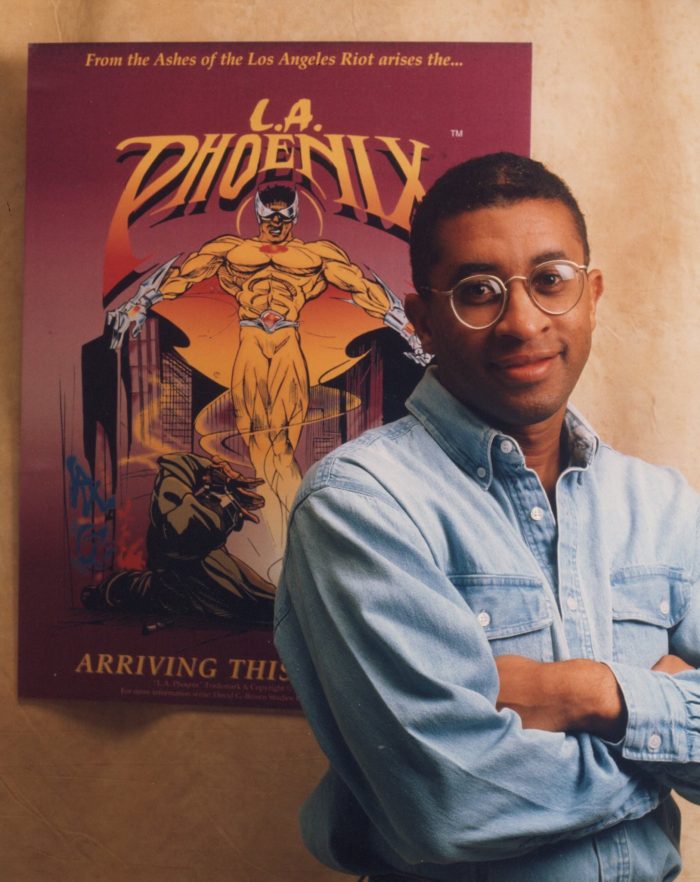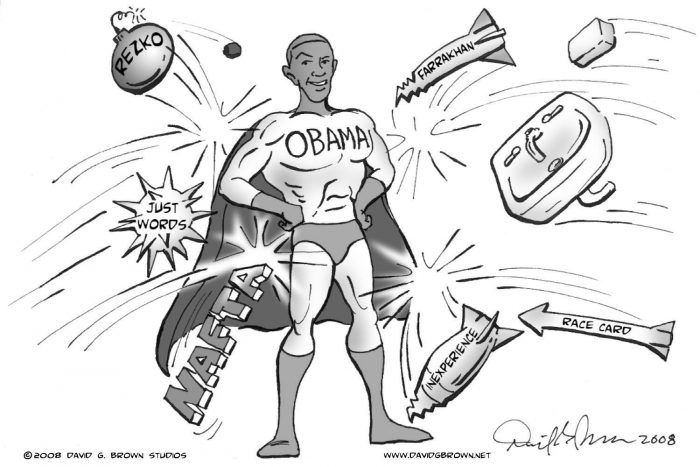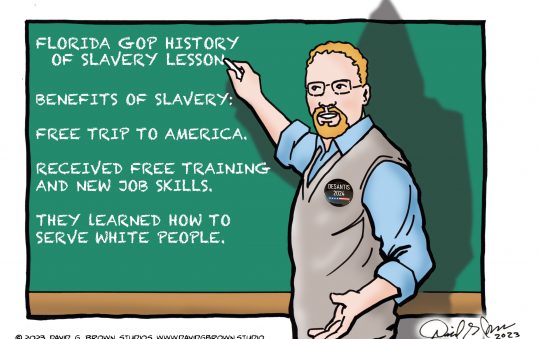
In his latest book “Barack, Race and the Media: The Obama Legacy”, award-winning artist, educator and publisher David G. Brown has accumulated his political cartoons which chronicle the former president’s journey as the first African American President of the United States of America.
Brown was born in Philadelphia, Pennsylvania and raised in a small town called West Atco in Southern New Jersey one of six siblings. He attended Edgewood Regional High School in Tansboro, New Jersey. Brown went on to attend Richard Stockton State College and earned a BA Studio Arts in 1978. He also attended Philadelphia College of Art where he studied marketing and advertising and Temple University, where he studied business. Brown would later move to Los Angeles and continues to learn having taken several classes at UCLA Extension.
“I consider myself a lifelong learner,” said Brown. [I’m] always looking for opportunities and experiences to grow from.”
Brown is a primarily self-taught artist, inspired by his mother and two older brothers who were blessed with natural artistic talent. While in college, he worked for the student newspaper doing editorial cartoons and eventually became an assistant editor for the publication. After graduating, Brown began working for several design studios and advertising agencies.
He has been awarded multiple prestigious merit awards including Best Editorial Cartoon from the National Newspapers Publishers Association (NNPA). Pelican Publishing Company Inc. featured his work in the 2005 thru 2014 editions of the “Best Editorial Cartoons of the Year”. He’s been awarded numerous PRAME (Public Relations Marketing Excellence) awards, the American Graphic Design, International Davey Silver and Communicator Print Media Awards. Brown is most proud of his NAACP Image award for his book “Barack, Race and the Media: Drawing my own Conclusion”.
Outside of working on editorial cartoons, Brown teaches and produces award-winning comics. The versatile commercial artist and producer client roster boasts promotional work for Los Angeles International Airport, Automobile Club of Southern California, Warner Bros, city of Los Angeles, Wells Fargo Bank, California African American Museum, ABC-TV and others. In October of 2009, the U.S. State Department and Brazilian Consulate sponsored an art exhibit and cultural exchange visit for Brown to Brazil. In October 2011, he was awarded Stockton College’s School of Humanities Professional Achievement Award.
The Sentinel had a chance to catch up with Brown recently and talk to him about his career, his latest book and advice for up-and-coming artist.
Los Angeles Sentinel Newspaper: Who/what were some of your inspirations growing up?
David G. Brown: My mentors include my father, who taught me the value of a strong work ethic and mother who gave me the gift of creativity and taught me to “Keep GOD First, believe in yourself and be willing to work hard for what you want.” In addition my older brother Tony Brown who is talented painter and illustrator, high school art teacher, co-workers and friends who took the time to care and encourage me.
LAS: Tell me about some of the illustrations/projects you are most proud of.

DB: After the Los Angeles Civil Unrest I was inspired to create the “L.A. Phoenix” comic book trilogy which launched my book publishing career. As a boy, I read comic books like every other kid, and always wanted to create my own with a black superhero, something I didn’t see growing up. But not until after the L.A. riots did I see comics as vehicle to express myself. The mission of the “L.A. Phoenix” was to show youth there were other ways of dealing with conflict than violence (the unrest). Phoenix uses all non-lethal weapons and focuses on address community issues, such as gang violence, graffiti and drugs. Some of my other projects include: The West Adams District (I published for the Auto Club), Steps to a Drug Free Life, Intersections South Central (CAAM and Auto Club), Simon Rodia’s Watts Towers, Dying to Smoke (NAACP) and FASTER (Auto Club).
LAS: What led to you doing editorial cartoons? Tell me why you feel editorial cartoons are important to a newspaper.
DB: I started doing editorial cartoons for my college newspaper, then after graduating from college a company newsletter for the design firm I worked for at the time. I think editorial cartoons are important because I feel the role of any editorial cartoonist is to educate, inspire and enlighten his or her audience about issues that impact their community and the world. Images are very powerful and can have a greater and emotional impact on the reader. Unfortunately, especially communities of color, we are living in a society where many of us do not read! Unfortunately, with the decline of the newspaper industry (Editorial cartoonist are primarily employed by newspapers) there are fewer of us. I am one of the only African American cartoonists in the United States that works for a weekly newspaper. The majority of cartoonists on staff for the major newspapers are middle aged White men. Who could care less about issues that impact communities of color or women. All the more reason why my role is important in acknowledging and addressing those issues that are often over looked by the main stream media.

LAS: Tell me about “Barack, Race and the Media: The Obama Legacy”. What does this book feature and why should people take notice? How long did it take to put this book together?
DB: “Barack, Race and the Media: The Obama legacy” is a book featuring a collection of political cartoons focusing on the journey and legacy of the first African American President of the United States of American, Barack Hussein Obama depicted from the perspective of a diverse group of political cartoonists. Inspired by the NAACP Image award-winning Political cartoon book “Barack, Race and the Media: Drawing my Own Conclusions” originally published in 2008. The book will feature the work of Los Angeles Sentinel newspaper cartoonist David G. Brown, Angelo Lopez, Lalo Alcaraz, David Horsey, Tim Jackson and Steve Greenberg. I think it is important for our community and country keep the legacy and efforts of our 44th President alive in our minds. Especially, enlighten of our current leadership in Washington. And not allow them to undo, tarnish or discredit all the positive things that Obama did during his 8 years in office.
LAS: Do you have any advice for up-and-coming artist or cartoonist? What steps do they need to take to have their work seen?

Courtesy Photo
DB: First of all, realize that being a creative, especially an artist, is very competitive, you will have to work very hard and deal with a lot of rejection. If possible, seek out a mentor who is doing what you want to do. Utilize social media to promote yourself and your brand. Most of all, be true to what you believe and your audience will find you!
Brown is a member of the IOTA PHI THETA fraternity, 100 Black Men Los Angeles and the Association of American Editorial Cartoonist. He also serves on the board of directors of the Museum of African American Art Los Angeles, where his primary role is to contribute to the defining of the mission, governing and success of the museum. Brown has one child, Damon David Brown, who is a journalist.
Brown will be having a book signing and artist talk on Sunday, March 11, 2018 @ 2:00 to 4:00 PM at the Museum of African American Art/Baldwin Hills/ Macy’s 3rd Floor located at 4005 Crenshaw Blvd. in Los Angeles, CA 90008. For more information, please visit www.maaala.org.
For more info on David G. Brown, please visit, http://www.aaeconline.org/cartoonist/profile.cfm/BrownD/






